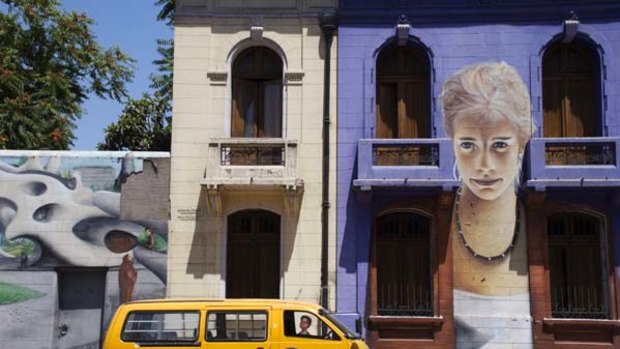
Trompe l'oeil ... murals adorn some of Santiago's facades.Credit: Krzysztof Dydynski/Lonely Planet
Travellers used to skip Santiago, but Vicky Baker finds new life after the earthquake.
This is most definitely not the new caipirinha, I think as I take a sip of my first terremoto cocktail in downtown Santiago. A mix of sweet fermented wine, pineapple ice-cream and fernet (a herb-infused spirit that tastes a little like dentist's mouthwash), it defies all sense and, quite quickly, all sobriety.
The terremoto - meaning earthquake - is the house specialty at La Piojera, an infamous downtown drinking den in the Chilean capital. The story goes that the drink earned its name after being concocted from the few ingredients available after the big 1960 earthquake, or because one too many will make your legs tremble.
I'm here just a couple of months after February's devastating 8.8-magnitude quake and surely it's too soon to order a terremoto. Then I notice almost every patron is clutching a plastic pint glass filled with the stuff. In Santiago, 300 kilometres north of the epicentre, life goes on.
Although the capital was nowhere near as badly hit as the second city, Concepcion, I find the clean-up here is, nonetheless, remarkable. A visitor arriving today is likely to note just a few telltale cracks and some extra scaffolding.
The city's comeback has positioned it at the forefront of a campaign to encourage tourists to return. This is not the easiest of tasks. Even before the disaster, the capital had a reputation for being, well, a bit boring. Though ideally positioned - just an hour from the coast, less than two hours from ski slopes and just 30 minutes from vineyards - the city is generally regarded as a quick stop on the way to somewhere else.
Until recently there was no outstanding boutique hotel flying the flag as a destination for an aspirational city break. The Aubrey opened this year, transforming two rundown 1920s mansions into the city's hottest property, at the foot of Cerro San Cristobal, the city's second-highest peak. The British-Australian owners have spent three years restoring the mission-style buildings, retaining art deco wood panelling and creating a stylish, hybrid interior that mixes Tom Dixon lamps with 17th-century oil paintings.
The Aubrey is part of the transformation of the Bellavista neighbourhood. With its colourful houses, cafes and nightlife, the area is best known as a student hang-out and a stop-off for those visiting the home of the late poet Pablo Neruda. Although the barrio prides itself on Patio Bellavista (patio.cl), a sleek complex with a sushi bar and a rock-themed restaurant, its real character lies in a traditional cite (alleys of houses) or with an unpretentious dinner at somewhere such as El Caramano (Purisima 257, caramono.tri pod.com), a former speakeasy serving Chileno classics such as pastel de jaibas (crab casserole) and machas a la parmesana (razor-clam gratin).
Santiago is often thought of as lacking the passion and spark of other Latin capitals. I wonder if this is, in part, due to many tourists basing themselves uptown, where the skyscrapers, wide streets and American chain stores feel sterile.
I sign up for a walking tour of downtown with La Bicicleta Verde, designed to take in the city's ''B side'' attractions. And this leads me to the terremotos of La Piojera (Aillavilu 1030, lapiojera.cl). Starting in the Patronato area, home to many of the city's Middle Eastern and Asian migrants, we try ''the best seafood empanadas in the city'', before exploring the sprawling La Vega market and the irresistible Mercado Central.
Before winding up at La Piojera, we visit one of the city's infamous cafes con piernas. A ''coffee with legs'' has scantily dressed waitresses serving coffee on an ogle-but-don't-touch basis. The story goes that, as there was no coffee culture in Chile in the 1950s, they had to add an extra incentive to get workers to make a coffee break part of their day. I pluck up the courage to step behind the seedy neon sign and blacked-out window of Cafe Romeo (21 de Mayo 580). I'm in a small, dark room with my guide and six half-naked women. I down my ultra-sweet cortado and head back into the light of day.
''The restaurant scene here is booming,'' says Liz Caskey, an American expat who runs culinary tours of the city and has written a food-and-wine guide (eatwineguides.com). One place, with a current waiting list of more than a week, is Pasta e Vino at The Aubrey.
Beyond Bellavista, Caskey recommends the district of Bellas Artes/Lastarria, with second-hand bookshops and antiques shops alongside Vietnamese restaurants and an ice-cream parlour (Emporio la Rosa, Merced 291).
Everywhere I visit on this trip is within walking distance of my Bellavista base. Downtown Santiago is recovering well. As the general manager of Turismo Chile, Pablo Moll Vargas, told a recent conference: ''This earthquake got one of our knees on the floor but not both.''
Rooms at The Aubrey cost from $US240 ($256), see theaubrey.com. La Bicicleta Verde's Santiago Huachaca walking tour costs $US60, see www.labicicletaverde.com.
- Guardian News & Media
Sign up for the Traveller Deals newsletter
Get exclusive travel deals delivered straight to your inbox. Sign up now.